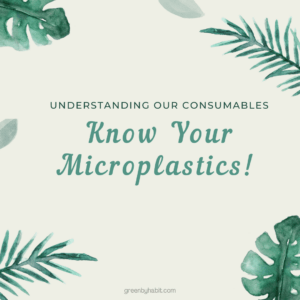Opinion
Building Green habits: Know your microplastics
Sruthi Surendran
This article is more than 3 years old.

In my previous columns, I have been looking at simple frameworks to make small but impactful sustainable changes in our daily lives. The goal was to be more mindful of our consumption habits and create less waste.
In this column, I wanted to zoom in on another aspect – something that happens while we are using certain daily items. This is a phenomenon we can’t see with our eyes as it happens at a micro level. But this has a huge impact on the environment and our health. It is the release of microplastics from our daily use items.
What are microplastics?
Microplastics are small fragments of plastics (< 5 mm). Microplastics enter air and waterways, posing threat to ocean life and end up in food chains (especially seafood). Recently they have been reported even in human placenta and bloodstreams.
But where do they come from? The root cause of microplastics is that plastics don’t decompose like organic matter, but only degrade into smaller pieces, eventually becoming microplastics.
There are many products we use in our daily life that release microplastics because that is what they are designed to do!
Common sources
You’re best advised to check the ingredients before you buy any product, even though manufacturers routinely drum up ways to mislead consumers about what they’re actually buying.
To make it easier for you, here’s a quick overview of a few of the biggest culprits.
Dishwashing sponges – we’ve probably all at some point, with good intentions, invested in a bumper pack of colourful synthetic dishwashing sponges. Every time we wash dishes with these sponges, tiny fibres are released. Some end up getting filtered at wastewater facilities, but an awful lot end up in rivers and oceans. A good alternative is to choose sponges made of natural fibres like coconut husk, wood fibre etc. They are available in most supermarkets and web shops in Denmark
Microbeads in household goods – you know those shiny sparkling beads in toothpaste and facewashes that promise gentle exfoliation? Yup, they are the culprits. If washed down the drain after use, they end up in our rivers and oceans. The best option is to choose products without microbeads. There are also some alternatives with bio beads on the market.
Glitter – most of them are plastics (PET) with a coating of aluminum. Avoiding glitter is the best alternative. There are a handful of companies now venturing into biodegradable glitter – but it will take some time before they are available widely.
Tea bags – this may be a shocker, but many, many brands use plastic in their product, and when the bag is steeped into the water, up to 11 billion (yes that many) microplastics can be released into your cup of tea. The best course of action is to find a brand that has eliminated plastic in its bags – PG Tips is a good example – or to simply use a reusable filter and fill it up with loose tea leaves.
Synthetic clothes – the clothes we stand in shed microplastics because that’s what most of them are made of. An estimated 35 percent of ocean microplastic pollution is derived from textiles: from polyester and nylon to our spandex cycling shorts. Approximately two-thirds of all textile items are now synthetic, dominated by petroleum-based organic polymers such as polyester, polyamide and acrylic. The best alternative is to choose natural fibres such as cotton or hemp. But that’s still going to leave you with half a wardrobe of synthetic clothes! Follow our tips and tricks in the factbox below, so we can minimise their impact on the environment.
It starts with small steps!
We are in a world where microplastics are everywhere and are unfortunately unavoidable. But let us take some small steps to minimise our impact.
Check out @greenbyhabit on Instagram for short videos and fun reels discussing these topics in detail.
Tips and tricks
Washing machines are proven to release more microplastics from clothes – a process known as ‘shedding’, which is exacerbated when the loads aren’t full.
Tumble drying is proven to be very aggressive on materials and it also releases a lot of microplastics. Air-dry whenever possible.
Please note that the microplastic shedding levels can very much depend on the material: how tightly woven they are, friction exposure etc.

About
Sruthi Surendran
Sruthi, from India, moved to Denmark in 2014 to pursue a career within green energy technologies (biofuels, waste treatment, offshore wind). Through her passion project greenbyhabit.com, she supports others keen to embrace greener habits. Follow her on the Instagram handle @greenbyhabit, where she shares her sustainability journey and breaks down these topics in a more fun and simplified format










































